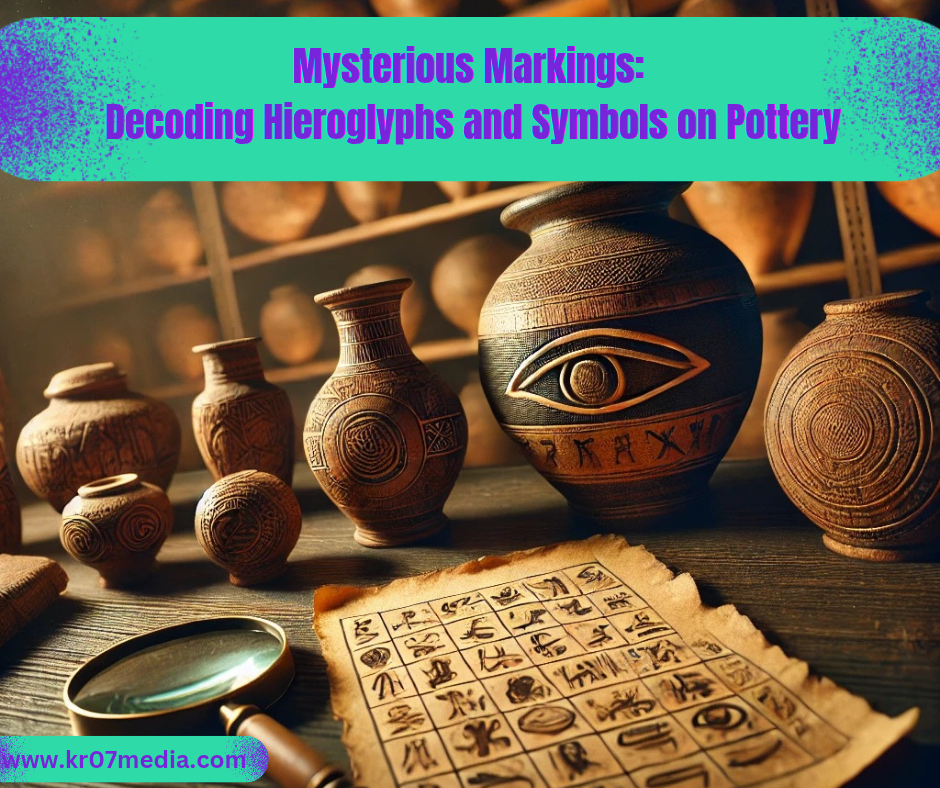Throughout history, pottery has served as more than just a utilitarian object—it has been a canvas for ancient civilizations to communicate, record events, and express their artistic and spiritual beliefs. Many of these ceramic pieces bear mysterious symbols, hieroglyphs, and inscriptions that provide valuable insights into past cultures. Deciphering these markings can reveal hidden stories about trade, religion, and daily life in civilizations long gone.
The Role of Symbols on Pottery
Pottery, being a durable and widely used artifact, often became a medium for inscriptions and artistic depictions. The symbols and hieroglyphs found on pottery pieces were used for various purposes, such as:
Identification and Ownership: Many pots were marked with seals, signatures, or clan symbols to indicate their maker or owner.
Religious and Ritualistic Significance: Symbols related to gods, myths, and rituals were commonly painted or carved onto pottery used in religious ceremonies.
Communication and Trade: Pottery was a widely traded commodity, and markings often indicated origin, weight, or content, helping merchants conduct business.
Historical Record-Keeping: Some civilizations, like the Egyptians and Mesopotamians, used hieroglyphs or cuneiform inscriptions to document important events or decrees.
Decoding Ancient Hieroglyphs and Symbols
Archaeologists and epigraphists use various methods to decode these mysterious markings:
1. Egyptian Hieroglyphs on Pottery
Ancient Egyptian pottery often bears hieroglyphic inscriptions that include names of pharaohs, religious invocations, and details about trade routes. Many of these symbols have been deciphered using the Rosetta Stone, which provided a key to understanding Egyptian writing. Symbols like the ankh (☥), representing life, and the scarab beetle, symbolizing rebirth, are commonly found on pottery.
2. Cuneiform Symbols on Mesopotamian Pottery
The Sumerians and Babylonians used cuneiform script, one of the earliest writing systems, to inscribe details about ownership, taxation, and goods on clay tablets and pots. These wedge-shaped markings have been decoded using comparative analysis with known texts.
3. Mysterious Indus Valley Symbols
The Indus Valley Civilization (3300–1300 BCE) left behind pottery with unique script-like symbols that remain undeciphered. Some researchers believe these could be a form of writing or a symbolic representation of trade guilds or religious beliefs.
4. Greek and Roman Pottery Marks
Greek and Roman pottery often features painted symbols, maker’s marks, and inscriptions related to mythology. The Greeks also used black-figure and red-figure pottery, where painted scenes often depicted stories from epics like the Iliad and Odyssey.
5. Pre-Columbian and Native American Pottery Symbols
Cultures such as the Maya, Aztec, and Ancestral Puebloans created pottery adorned with glyphs and pictographs. The Maya developed a complex system of hieroglyphs that recorded history, while Native American pottery often featured geometric patterns and animal motifs with spiritual significance.
Challenges in Deciphering Ancient Symbols
Despite advancements in archaeology and linguistics, many pottery inscriptions remain undeciphered due to:
Lack of bilingual inscriptions (like the Rosetta Stone for Egyptian hieroglyphs).
Limited contextual information about how these symbols were used.
The possibility that some markings were purely decorative rather than linguistic.
The Ongoing Mystery and Future Discoveries
New technologies, including AI-assisted pattern recognition and X-ray fluorescence analysis, are helping archaeologists uncover hidden inscriptions and better understand ancient pottery markings. Each discovery brings us closer to unlocking the secrets of these mysterious symbols and gaining deeper insights into the lives of our ancestors.
Pottery is more than just broken shards in an archaeological dig—it is a tangible link to human history, carrying stories waiting to be deciphered. As researchers continue to uncover the meanings behind these markings, they reveal not only the artistic brilliance of ancient civilizations but also the enduring human desire to communicate across time.



